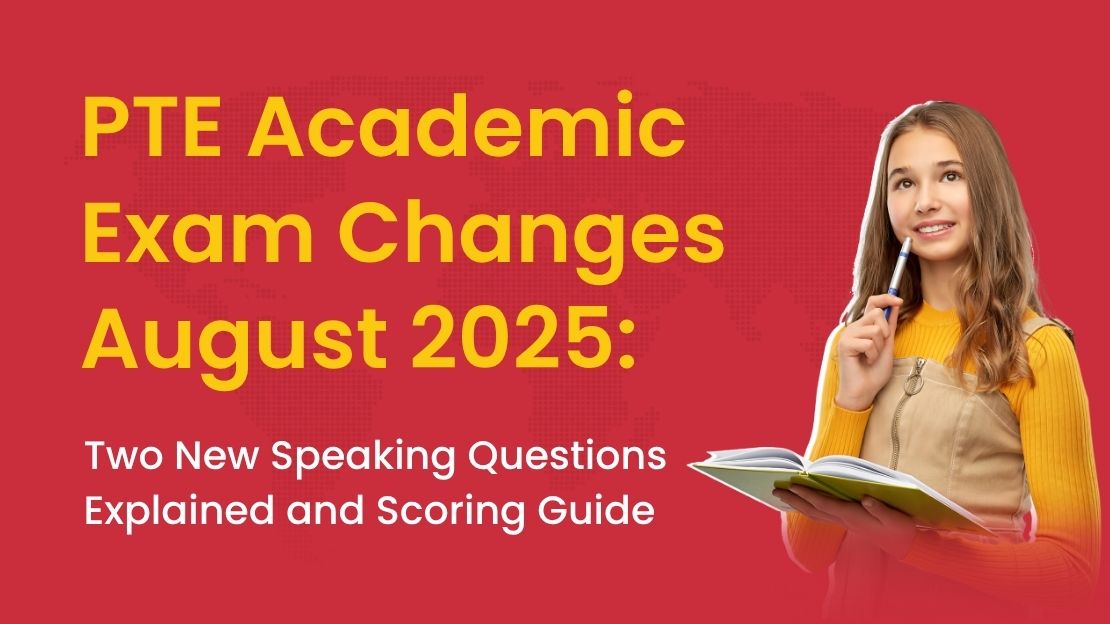PTE Exam 2025 Speaking Update: Get Ready for the New Task Types and Smarter Scoring

If you’re planning to take the PTE Academic after August 7, 2025, there’s something important you need to know. The New PTE Question Types 2025 are arriving, and with them come some major updates to the Speaking section. These changes are designed to help the test reflect real-world communication—whether you're speaking at university, in the workplace, or simply having a casual conversation. Let’s dive into what’s changing and how you can prepare to ace the exam!
📌 Why Is the Speaking Format Changing?
The main reason for these updates is simple: to make the PTE more practical and relevant to how we use English every day. In the past, Speaking tasks mostly focused on your ability to pronounce words and repeat sentences. But in real life, effective communication goes beyond that. We need to listen, respond quickly, and solve problems through conversation.
The new format will test your:
Active listening skills
Ability to think quickly
Real-world speaking abilities
This shift is all about communication—not just language skills.
🆕 What’s New in the Speaking Section?
Starting in August 2025, two exciting new tasks will be introduced in the Speaking section:
Summarize Group Discussion
Respond to a Situation
These tasks will replace some of the older, more repetitive tasks with ones that mirror real conversations you might have in daily life.
🗣️ Task 1: Summarize Group Discussion
What Happens in This Task?
In this task, you’ll listen to a short group discussion (about 2–3 minutes) between 3–4 people on an academic topic. Your job is to summarize their main ideas in a formal, clear tone—without sharing your own opinion.
Skills This Task Tests
Understanding group conversations
Recognizing different viewpoints
Summarizing in a neutral, concise manner
Tips to Do Well
Take quick, organized notes while listening.
Start with a clear introduction: “The discussion focused on…”
Briefly mention what each speaker contributed.
If you have time, end with a well-rounded conclusion.
What to Avoid
Don’t share your own opinions.
Be careful not to confuse which speaker said what.
Avoid casual or emotional language.
🎤 Task 2: Respond to a Situation
What Happens in This Task?
In this task, you’ll hear a real-life scenario—like someone asking for help, filing a complaint, or expressing concern. You’ll have 10 seconds to prepare and 40 seconds to respond, acting as if you’re part of the situation.
Skills This Task Tests
Quick thinking and clear responses under pressure
Speaking politely and helpfully
Providing relevant, actionable solutions
Tips to Do Well
Start by acknowledging the situation: “I understand your concern…”
Offer a specific solution or next step.
Close politely with something like, “Let me assist you with that.”
What to Avoid
Avoid sounding robotic or overly rehearsed.
Don’t give vague or unclear answers—be specific.
Don’t overuse complicated words—clarity is key.
🎯 Why These Tasks Are Important
These new tasks aren’t just exam changes; they’re helping you prepare for real-life situations. Whether you’re heading to university abroad or planning to work internationally, you’ll need to:
Contribute to group discussions
Solve problems through conversation
Stay calm and clear under pressure
These tasks help you build those practical skills while making your English more relevant to the real world.
🔍 How Will These Tasks Be Scored?
The new Speaking tasks will be scored using a combination of AI and human raters. Here’s what they’ll look for:
Fluency: Are you speaking naturally, without hesitation?
Pronunciation: Are your words clear and easy to understand?
Content: Did you provide the right type of response?
Appropriateness: Was your tone fitting for the situation?
📚 How to Get Ready for the New Format
🎧 Improve Your Listening
Watch debates, podcasts, or academic talks to practice listening for different viewpoints.
Focus on how people exchange ideas and challenge each other’s opinions.
🗣️ Practice Speaking Spontaneously
Respond out loud to everyday situations, such as explaining a process or resolving a problem.
Record yourself speaking and listen for your tone and fluency.
Try “mirror speaking” (speak while looking at yourself in the mirror) to boost confidence.
⏱️ Practice with a Timer
Use a stopwatch to practice 2-minute summaries of conversations.
Respond to random prompts in 40 seconds to simulate the real exam timing.
📘 Handy Phrases to Learn
For Summarizing Group Discussions
“The discussion centered around…”
“One speaker believed that…”
“Another participant offered a different view…”
“In summary, the discussion highlighted…”
For Responding to Situations
“Thank you for bringing that to my attention…”
“I understand your concern…”
“Let me explain how we can solve this…”
“Here’s what I recommend moving forward…”
📱 Tools to Help You Prepare
Apps: PTE Tutorials, E2 Test Prep, PTE Master
YouTube Channels: E2Language, Alpha PTE, Angel EduNext
Mock Tests: Practice weekly with timed tests and feedback
Flashcards: Create a deck of useful academic and real-life phrases
💡 Final Thoughts: Be Ready, Not Just Prepared
The New PTE Question Types 2025 aren’t just about passing the test—they’re about proving that you can use English effectively in real-life situations. Whether in class, at work, or in social settings, these changes are designed to help you become a more confident communicator.
With the right preparation, you’ll not only pass the exam—you’ll impress. Focus on understanding, stay calm under pressure, and practice every day. You’re not just learning English; you’re learning how to use it in the real world.
Source: Angel EduNext
